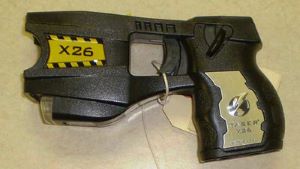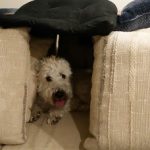If only they could talk… Dogs cannot talk, but that doesn’t mean they do not communicate.
They do quite a lot and it’s your responsibility as their human friend to understand just what they’re trying to tell you.
For instance, examining a dog’s sleeping position can help you understand how they’re feeling, whether they’re relaxed, anxious or ready to spring back into action.
One of the most common sleeping positions for dogs is with the paws tucked under.
The dog looks most comfortable and cozy, but is he really? In this article we’ll examine this and other dog sleeping positions, as well as other ways dogs use their paws to communicate.
The table below shows everything that you will learn from this article.
- Two reasons that my dog tucks his paws under when he lies down?
- Four sleep positions that show a dog is comfortable
- Why do dogs curl their paws whilst asleep?
- Why does my dog curl his paw whilst I pet him?
- How else will a dog communicate with their paws?
- Why do dogs flex their paws?
- What causes paw knuckling?
- How should knuckling be treated?
- Closing Thoughts
Two reasons that my dog tucks his paws under when he lies down?
There are actually two positions when the dog sleeps with his paws tucked under and they indicate different things.
Curled up
When a dog sleeps all curled up in a ball, head to tail with the paws neatly tucked under, this is called the fetal position.
Dogs often prefer this position because it offers maximum protection. Curling up allows a dog to protect the most important part of his body, his underbelly.
It is a position common for animals in the wild, so maybe it’s partly dictated by instinct.
On the other hand, canines or other animals in the wild curl up in a tight ball to protect against aggression.
If a house pet does this that should ring an alarm bell as it indicates your beloved pet doesn’t feel quite comfortable.
Curling up and tucking his paws is a sign that your dog doesn’t feel protected enough. It might be a sign of anxiety, which also affects dogs.
They don’t have many ways of expressing if there’s something troubling them so you should take notice.
If your dog usually sleeps curled up it might also mean that he’s a bit cold.
Animals in the wild use this position as it allows them to conserve warmth.
Among house pets, dogs adopt this sleeping position more frequently over the cold season.
Even if the house seems warm enough to you, keep in mind that dogs sleep at floor level where it’s a bit more drafty.
If you see your dog curling up and tucking his paws in his sleep, perhaps you should consider putting a light blanket over him.
Belly down
This doesn’t seem as cozy as the fetal position and it is a clear sign of anxiety.
When the dog lies down with the belly on the floor and his paws tucked under, this indicates fear or submission. It is common among young dogs or puppies trying to adapt to new surroundings.
If you’ve just got the dog, don’t be surprised to see him sleeping like that. At this stage, he’s still evaluating his new digs and his new family.
You may seem like nice people, but he doesn’t really know what to expect of you so, for the time being, he’s being cautious and he sleeps with his vital organs well protected.
This will pass and, once the dog feels more confident, he’ll probably switch to a more comfortable sleeping position.
Four sleep positions that show a dog is comfortable
Belly up
When a dog lies flat on his back, with his belly up and paws in the air, it’s not just that he looks adorable, he’s also totally relaxed.
Maybe this position doesn’t seem quite comfortable to you as we, humans, don’t sleep with our limbs in the air, but it’s perfectly natural for a dog.
The fact that the dog leaves his underbelly totally unprotected indicates that he feels perfectly secure in his environment.
There are no dangers lurking so he can afford the luxury of sprawling with their paws in the air.
This position is more common in summer as it allows the dog to cool off.
As you probably know dogs don’t sweat through their skin like humans, but they do have sweat glands in their paws.
When a dog sleeps with his paws up in the air, they can eliminate excess heat easier. Also, the fur on the underbelly is short and fine so he probably appreciates the air against his skin.
On the side
Many dogs prefer to sleep on their side with their legs stretched out in front of them. This position indicates the dog feels pretty relaxed and he has no fear of leaving his underbelly exposed.
When a dog sleeps on the side, this gives him plenty of room to move his limbs while he’s dreaming.
You’ll often see his limbs twitching or it will seem like he’s running around in his sleep. Don’t disturb him, he’s probably in the park or chasing a cat in his dream.
Snuggle-up
When the dog jumps into your bed and snuggles against you, this is a clear sign of affection. He may be looking for warmth, both physical and figuratively-speaking, but it’s also a sign of trust.
Your pet has no problem sleeping with you because he knows you’re no danger. On the contrary, you’re their protector.
If your dog likes to sleep with a paw on you, this indicates affection but also the need for reassurance. You’re his favorite human and he wants to keep you close, make sure you won’t disappear.
Superman
When a dog lies flat on his belly with his legs stretched out, this is sometimes called the Superman position.
No, your dog is not preparing to save the world, he just wants to be ready to pounce back on his feet and ready for action at the slightest sign of movement.
If his humans invite him to play, this position allows him to be up instantly.
This position appears more frequently among very energetic dogs who drop down with exhaustion in the middle of the room, but don’t want to spend much time napping.
Why do dogs curl their paws whilst asleep?
A dog curling his paws while he sleeps is looking to protect his soft and exposed underbelly. At the same time, sleeping like this allows him to conserve warmth by keeping the sweat glands in his paw against his body.
Why does my dog curl his paw whilst I pet him?
Now that’s a completely different thing. When a dog curls his paw while you’re petting him, this is his way of reciprocating affection.
He likes it when you curl your paw and rub his fur so he’s doing his best to imitate you.
Sometimes he ends up with a paw just hanging in the air, but often enough he’ll place his paw on your arm or leg to say that he, too, loves you.
How else will a dog communicate with their paws?
Have you ever experienced that mildly annoying feeling when you’re trying to work or read or watch TV and your pet keeps pawing at your legs?
It’s not a forceful movement, but it’s very persistent. This is probably the most common way for a dog to try to get your attention. He might not make any sound, you won’t hear him whimpering, but he’ll keep pawing until you drop whatever it is you’re doing and start talking to him or petting him.
Why do dogs flex their paws?
Sometimes a dog will raise one of his front legs and flex his paw when he knows he’s done something he shouldn’t have.
There you are holding your ruined sneaker and scolding your dog and he puts his paw up. It’s heart-melting! It’s like he’s trying to say ‘I’m sorry!’ or ‘Please, don’t be angry with me!’ and chances are you will soon forget all about it and give him a pat on his head.
You shouldn’t do that because you need to be firm when the dog misbehaves, but you probably won’t be able to resist.
What causes paw knuckling?
The way a dog walks or runs is often a good indicator of a health problem. Many pet owners are worried when they see their dog’s paws knuckling and this is indeed a symptom you shouldn’t overlook.
Knuckling under can be observed when a dog is up on his legs, at rest, or when he’s walking. He might not do that with every step he takes, but it’s something you need to look into.
In many cases, this might be caused by an injury or infection to the paw. The first step is to examine the affected paw and look for scrapes, cuts, inflammation or foreign objects, like pebbles, stuck in his paw.
In such cases, cleaning the paw and applying an antiseptic ointment might easily solve the problem.
However, paw knuckling can be a sign of various serious health conditions like:
- Arthritis
- Degenerative myelopathy
- Spinal problems, like cervical disc disease
- Neurological disorders
How should knuckling be treated?
If there’s nothing wrong with his paws and the dog keeps knuckling under, you should take him to the vet. Various tests might be needed to determine the cause of the knuckling.
You’ll have to treat the underlying health issue to get rid of the knuckling.
If your dog has a neurological disorder or needs surgery for a spinal problem, you might want to use no-knuckling socks for the rehabilitation period.
Such devices are available for both the front and the rear legs and offer joint support to help the dog place the affected paw correctly.
Another option is to have your dog wear boots, available at specialized pet stores.
However, if your dog has a degenerative condition such medical devices won’t be able to stop the progression of the disease, but at least they will help your dog walk more comfortably.
Also, your dog might benefit from personalized rehabilitation programs designed to build muscles and strengthen his legs.
Closing Thoughts
The position in which your dog sleeps can tell you a lot about his feelings. When a dog sleeps with his paws tucked under and curled in a ball, this might be a sign that he might be feeling insecure or anxious, but it’s also a sign he might be cold.
On the contrary, a dog sleeping with his belly up is a dog who doesn’t have a care in the world and he’s totally comfortable.
Always pay attention to the way your pet uses his paws to communicate. Paw movements are never random, your dog is trying to tell you something when he places a paw on you.







